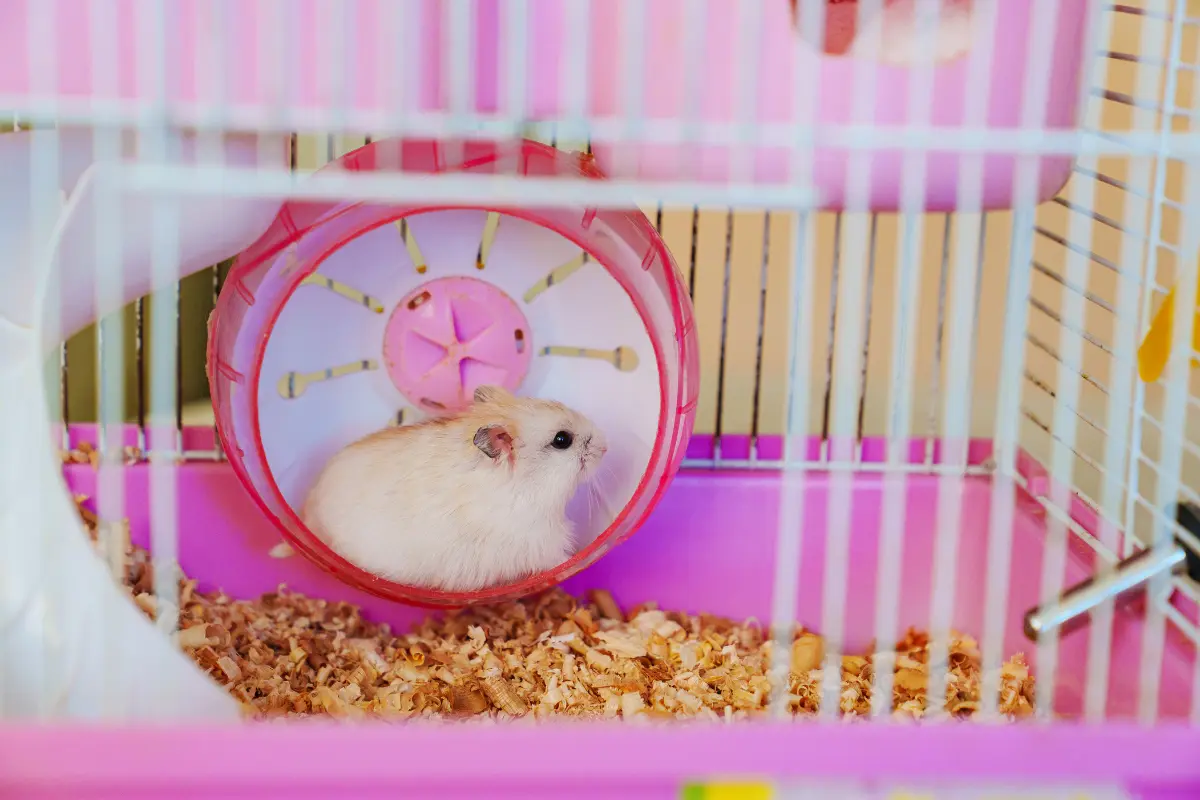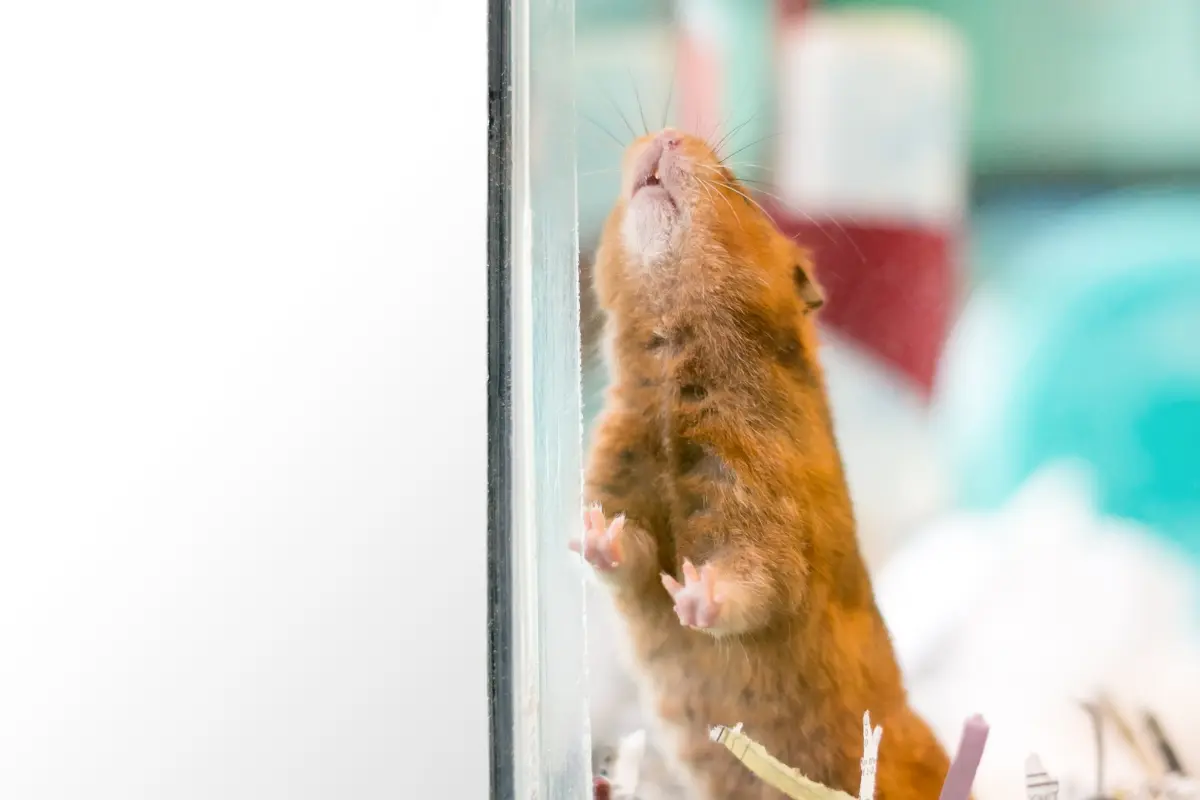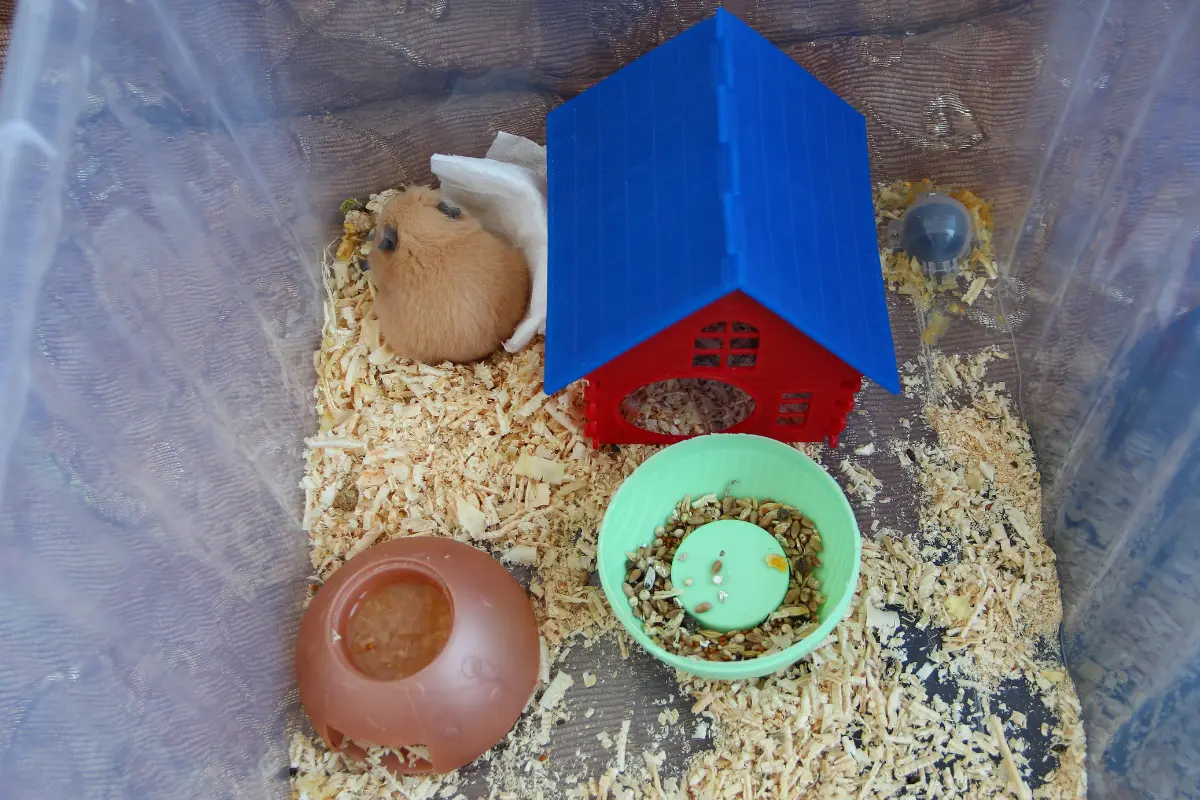Choosing a Hamster’s Cage: Glass Tank, Wire Cage, or Plastic Bin?
Selecting the right hamster cage is one of the most important decisions you’ll make as a pet owner. The type of cage you choose affects not only your hamster’s safety and comfort but also how easy it is to maintain the cage.
Let’s take a closer look at the advantages and disadvantages of each cage type.
Wire Cages: The Classic Choice
Wire cages are the most widely used hamster enclosures and have been a staple in pet care for years. These cages are typically made from metal bars with a plastic base, and many come with multiple levels, ramps, and accessories like water bottles, wheels, and tunnels.
Wire cages are popular because they are easy to find, reasonably priced, and offer a lot of ventilation.
Pros
- Ventilation: One of the biggest advantages of wire cages is their excellent airflow. Proper ventilation is essential for maintaining a healthy living environment for your hamster. With good airflow, humidity is less likely to build up, reducing the risk of respiratory issues.
- Affordable: Wire cages are often among the least expensive options. This makes them a great choice for pet owners on a budget but still want to provide their hamsters with a comfortable living space.
- Easy to Customize: The open structure of wire cages makes it easy to attach accessories like water bottles, toys, and wheels. You can also modify the cage with additional shelves or ramps for enrichment. Some cages even come with multi-level setups, giving your hamster more room to explore and climb.
- Easy to Clean and Move: Wire cages are relatively light and easy to handle. Most are easy to disassemble and clean thoroughly, which can save you time and effort when maintaining the cage. Their lighter weight makes them easy to move around when needed.
Cons
- Size Limitations: Many wire cages do not meet the size requirements for larger hamsters, such as Syrians. It’s crucial to choose a wire cage that provides enough space for your pet to move around comfortably. Cages that are too small can cause stress and lead to health issues.
- Bedding Spillage: Because of the open bar design, bedding can easily spill out of the cage, especially if your hamster is an active digger. This can create extra messes outside the cage, requiring frequent cleanup.
- Escape Risks: If the spacing between the bars is too wide, especially in smaller wire cages, there’s a risk that your hamster may slip through and escape. This is particularly a concern for dwarf hamsters, who are small enough to squeeze through the gaps.
- Chewing and Injury Risks: Some hamsters, especially those who are stressed or anxious, may chew on the metal bars. This can lead to injury to their teeth and gums. In addition, climbing on the bars can result in falls or other injuries if the cage is not stable enough.

Best For
Wire cages are best suited for hamster owners who want an affordable, well-ventilated cage with room for accessories and enrichment. They work particularly well for hamsters that enjoy climbing and exploring.
However, it’s important to ensure that the cage is large enough, the bar spacing is appropriate, and there is no risk of your hamster escaping.
If you’re looking for a cage that is easy to clean and move around, a wire cage is a solid option, but you’ll need to make sure it meets the specific needs of your hamster.
Glass Tanks: Secure and Spacious
Glass tanks, often repurposed aquariums, offer a secure and spacious option for hamsters. These tanks are typically made from thick, durable glass and feature a solid base, providing a chew-proof environment for your hamster.
Glass tanks are a great choice for owners seeking a large, enclosed space for their pet, especially if they want to avoid the potential for their hamster to escape or chew through its cage
Pros
- Security: Glass tanks are virtually escape-proof. Hamsters cannot chew through the glass, making it a great choice for hamsters that are escape artists or those that are prone to chewing on cage materials like plastic or metal.
- Ample Space: Glass tanks, particularly those of larger sizes (such as a 75-gallon tank), offer a generous amount of floor space for your hamster. Syrian hamsters, in particular, benefit from the expansive area where they can roam, burrow, and build nests. The extra space also allows for a more enriching environment with various accessories like tunnels, bedding, and platforms.
- Easy to Maintain: Glass is non-porous and easy to clean. Unlike plastic or metal cages that might absorb odors over time, glass surfaces can be wiped down, and the tank can be thoroughly sanitized without any issues. This helps maintain a fresh environment for your hamster.
- Visibility: The clear glass allows for excellent visibility, giving you the ability to easily observe your hamster’s behavior and activities. It’s also more aesthetically pleasing and can fit in with a variety of home decors.
Cons
- Weight and Portability: One of the major drawbacks of glass tanks is their weight. Larger tanks, in particular, can be very heavy, making them difficult to move around or clean. You’ll need a sturdy surface or furniture to support the tank, and it may require multiple people to move it safely.
- Fragility: While glass is durable, it can shatter if dropped or mishandled. This makes glass tanks less practical if you need a cage that can withstand rough handling. If the tank breaks, it can create a mess and potentially harm your hamster.
- Ventilation Concerns: Although glass tanks can be sealed to be escape-proof, poor ventilation can lead to humidity buildup, which is problematic for both your hamster and the tank’s hygiene. Some tanks come with mesh lids or require you to drill holes to ensure proper airflow.
- Cost: Glass tanks, especially large ones, tend to be more expensive than other cage options. If you’re on a budget, a glass tank might not be the most affordable choice. Acrylic tanks are a lighter alternative, but they can be even more expensive.

Best For
Glass tanks are an excellent choice for hamster owners looking for a secure, spacious, and chew-proof cage. They are particularly suitable for hamsters that are prone to chewing on other materials or trying to escape.
The ample space allows your hamster to have an enriching and comfortable environment. However, you’ll need to ensure proper ventilation and be prepared for the weight and cost associated with glass tanks.
If you want a long-term investment and have the space to accommodate a large tank, a glass aquarium can provide a safe and beautiful home for your hamster.
3. Plastic Bin Cages: Budget-Friendly and Customizable
Plastic bin cages have gained popularity as an affordable and customizable option for hamster enclosures. Made from large, sturdy plastic storage bins, these cages offer a spacious living environment for your hamster while allowing for DIY customization.
For those on a budget or looking for a more hands-on approach to hamster care, plastic bin cages provide a versatile solution that can be tailored to your pet’s needs.
Pros
- Cost-Effective: Plastic bin cages are often the least expensive option when it comes to hamster enclosures. You can usually find a suitable storage bin at a local store for a fraction of the price of a commercial glass or wire cage. For hamster owners who are budget-conscious, plastic bins are an ideal choice.
- Customization: One of the biggest benefits of plastic bin cages is how customizable they are. You can easily drill ventilation holes in the plastic, add mesh lids, and include additional features such as shelves, ramps, tunnels, or bedding for burrowing. This flexibility allows you to design a cage that suits your hamster’s specific needs.
- Lightweight and Easy to Handle: Plastic bins are much lighter than glass tanks, making them easier to move and clean. Unlike glass, which can be heavy and fragile, plastic bins are portable and can be handled without much difficulty.
- Easy to Clean: Cleaning a plastic bin cage is simple. The smooth surface of the plastic is easy to wipe down, and spills or messes are less likely to stick compared to other materials. You can quickly change bedding, remove soiled areas, and maintain a hygienic environment.
Cons
- Ventilation: Although plastic bins can be modified to include ventilation holes or mesh lids, the natural design of the bin limits airflow compared to wire cages or glass tanks with mesh lids. Without sufficient ventilation, the buildup of humidity and poor air quality can lead to health issues for your hamster. Ensuring proper airflow is critical, so be prepared to make necessary modifications.
- Chewing: While plastic bins are generally durable, some hamsters, especially those with strong chewing habits, may gnaw on the plastic. Over time, chewing can damage the bin and even create holes, compromising the security of the cage. Additionally, plastic is more likely to absorb odors compared to glass or metal, so it may require more frequent cleaning to prevent smells from lingering.
- Height Restrictions: Most plastic bins are relatively short in height, which can limit the amount of space your hamster has to climb or burrow. To compensate for this, you’ll need to add a substantial amount of bedding on one side of the bin to create enough depth for your hamster to dig and create a nesting area. This can take up valuable space, potentially limiting your pet’s other options for exploration.
- Aesthetic Appeal: While plastic bins are practical and functional, they are not the most aesthetically pleasing option for those who want their pet’s cage to blend seamlessly into their home decor. However, with a little creativity and some DIY upgrades, plastic bins can be made visually appealing.

Best For
Plastic bin cages are perfect for hamster owners on a tight budget or those who enjoy DIY projects.
They offer a cost-effective and customizable alternative to more expensive commercial cages, providing a spacious and secure environment for your hamster. However, plastic bin cages require some effort to ensure proper ventilation and to prevent damage from chewing.
If you’re willing to invest time in creating the perfect setup, a plastic bin cage can be an excellent and practical option for your hamster’s home.
DIY Cage Options: A Custom Solution
If you’re handy with tools, a DIY cage could be a perfect solution. Building your own hamster cage can provide the durability, space, and ventilation that commercial options might lack.
Building your own hamster cage can be relatively simple with the right materials:
- Base and Sides: Melamine panels or plywood are good choices for the base and sides of your cage. Melamine is waterproof, making it ideal for a hamster habitat. Panels are available at hardware stores in 2ft x 4ft sizes and are relatively affordable.
- Front Panel: You can use glass or acrylic for the front of the cage. If you opt for glass, make sure it’s thick enough (at least 3mm) to support the bedding and prevent breakage. Alternatively, you can use another piece of melamine for the front.
- Lid: A wire mesh lid is essential for ventilation and to prevent your hamster from escaping. You can create a frame using wood or metal and attach a mesh screen to allow airflow.
To construct your DIY cage, you’ll need basic tools such as a saw, drill, screws, and silicone sealant to hold glass in place. A basic drill can cost around $30, and if you don’t already have the tools, this can be an additional investment.
Ultimately, the best hamster cage depends on your budget, preferences, and your hamster’s behavior. No matter which cage you choose, make sure it provides ample space, good ventilation, and a safe environment for your hamster to thrive.






